#brutalist masterpieces
Note
please do not stop writing stranger things fanfictions! I have just read brutalist masterpieces instead of doing work and best hour of my day so far. Other than the fact that I want to know what happens after Steve comes to Thanksgiving! I have read the most remarkable thing so many times and I cannot tell you how much I love it.
i've been letting this ask sit in my inbox for so, so long, because i knew the day would come, and now it has:
title: your house is waiting
summary: Thanksgiving, 1996, in Evanston, Illinois; or, a sequel and an epilogue to brutalist masterpieces
excerpt:
There’s laughter coming from the living room still as Eddie ushers Steve through the open door with a gentle hand at the small of his back. The smell of food cooking, herbs and turkey and potatoes, envelopes them like a warm embrace, along with the faintest hint of cigar smoke that drifts down the hall from Hopper’s study. (That was a battle Robin had yet to win, though she remains determined, he knows.) They are also swiftly taken in by the heat of the house, almost oppressive compared to the world outside, but welcome all the same.
Eddie disengages from Steve briefly to shrug out of his hoodie and hang it on a hook by the door, among a bevy of other coats and shoes below too, so he toes out of his J’s as well. When he turns around, he’s still standing in the place where Eddie had left him, staring around them. His eyes are wide, his fingers are curled inward towards his palms in loose fists, and he follows his gaze to the credenza, and the wall behind it.
A small bowl, overflowing with various colorful sets of keys and debris from a dozen pockets, more, sits in the center of the plain thing, and a set of framed photos stand next to it: one of Hopper and Joyce the day they got married at the Cook County courthouse, Hopper pressing a kiss to Joyce’s temple with tears on his face; and then the second of them joined by their children, Jonathan holding his mother’s bouquet and looking vaguely mortified while El and Will are in hysterics and Hopper and Joyce continue to smile blissfully at each other, oblivious.
124 notes
·
View notes
Text
this might be controversial but I've never understood why people dislike SAI, or see it as less musically worthwhile? tøp has always crossed genres and bucked tradition, and given us a new sound every album.
I really love how versatile they are! and it feels like we were genuinely being spoiled the entire album :') like, there's a perfect mix of absolutely heartbreaking songs (Choker, Shy Away, Redecorate, No Chances, THE OUTSIDE!!!!), and upbeat boppy songs with even more soulcrushing hidden aspects to them (Mulberry Street, Saturday, Good Day, Never Take It & Bounce Man)
I feel like they perfectly fit the aesthetic of cheerfully deceptive and dystopic, whilst also continuing their concepts from Trench and exploring them. I like the theme of like, maladaptive positivity that covers a hidden misery and darkness as the boys try to navigate being trapped in a hopeless situation, the critique on the current social climate of being hyperaware n information overload, and also all the MISinformation that comes along with it.
I feel like it's JUST as narratively interesting and complex as Trench was but bc there have been almost no theorycrafters talking about it, it didn't get nearly the love and insight it deserves.
I love you SAI, I love you dystopic societies covered by a chipping layer of pastel paint, I love you societal critique about being dragged back into the throes of depression and feeling as though society dresses it up in flowery language to make it more palettable to them, I love you boys who never limit themselves to one sound or genre and instead explore them all and push them to their limits and experiment and keep things interesting forever, I love you twenty one pilots
#ALSO WE GOT TYLER WITH PINK HAIR AND A SLUTTY SLUTTY CROP TOP#IS THAT NOT ENOUGH!!!!!!#like ofc Trench is a masterpiece and like it's nearly impossible to top it but like#i don't feel like tyler and josh felt the need to prove themselves any more than they already have#the only way to improve on perfection is to diversify and expand your repertoire#and i feel like they did here#i love scaled and spicy soooo much#and every song every frame of their mvs is dense with meaning#they took a trend - 1960s nostalgia - and elevated it to something phenomenal#i love the addition of it to the world of trench because it aligns perfectly with the brutalist aesthetic#and it's intended era inspiration#god i could talk about SAI forever#mine#lorewhore
23 notes
·
View notes
Text


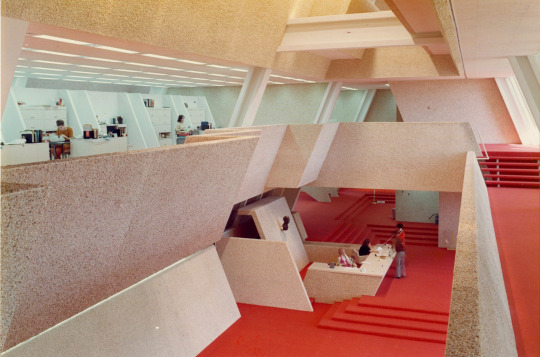

Paul Rudolph's Burroughs Wellcome building in North Carolina - a lost brutalist masterpiece - demolished just last year
a major location in Douglas Trumbull's troubled sci-fi film, BRAINSTORM
864 notes
·
View notes
Text
Possessed by Grief - an essay on MyHouse.pk3
Here's that essay on MyHouse.wad I've kept threatening to drop like a big anvil, which I definitely did not forget about for like a month :P Seems like an opportune moment to publish it, what with all the recent influx of interest in the game - and so I present some more of my thoughts on this masterpiece. Enjoy :)
MyHouse.pk3 is a game about grief.
It is a game about nostalgia and regret, obsession and devotion, confusion and despair. A game that asks if it's ever possible to escape grief's clutches, or if each apparent success only makes the net close tighter around us. A game that compels us to seek answers, and provides only further questions.
This is also a game about love, and how grief scrunches it up impossibly small and stretches it out impossibly thin, as we are forced to reckon with what this person really means to us, what impact they've had on us, and how we can possibly continue to exist in this world without them.
It is by all accounts a common thing for prospective modders to recreate their own houses, or those of their relatives, as part labour of love, part test run for future projects, part rite of passage. I imagine that playing through one is akin to a virtual property tour, with added demon killing and grunting. And perhaps this was all MyHouse.pk3 was ever meant to be - just another map of just another house, albeit uploaded as a tribute to its original owner who passed on.
What we get instead… is nothing short of an electronic manifestation of grief itself. The house changes as we play, as demons thought vanquished return stronger than ever. New hallways jut out at impossible angles while old doorways vanish into thin air. We wander through wildly different versions of the house's floorplan - a brutalist office block that changes in size, a perpetually-flooded bathhouse suspended in an eeriely tranquil skybox, an abandoned daycare falling into disrepair, an empty airport devoid of life, adjoined to a bathroom with a bloody secret. Mirrors become portals to alternate versions of the same house, where everything is the same except reversed. You jump out of a plane and seemingly wake up back at the house, but time has passed and everyone has moved on and the one thing you thought a concrete certainty ("Safe as houses", so the saying goes) is literally sold off behind your back and you turn around and there's nothing there anymore, it's just gone.
No-one asked you. You did not consent to any of this, and yet it has happened all the same.
And life ticks on and you try to move on but you can't. Even the Underhalls, Doom II's second level, provides only temporary respite, as you are immediately spat back out right where you began, and the whole process starts over.
THIS is what grief does to someone. It freezes you in time, folds your mind into endlessly recursive origami shapes that loop on themselves again and again, removes an old keystone from the bridge of your psyche before stepping back to watch the structure slowly crumble to ruins. You flail helplessly as you are caught between trying to invoke what you've lost in meaningful objects and places, and tossing everything aside and trying to escape into some new, different reality. The past contains bittersweet memories of happier times you can never return to, while the future promises nothing but a bleak pseudo-existence utterly devoid of meaning. You cannot go back. You cannot move forward.
And all the while, you torment yourself with the same questions, over and over and over: Why did this happen? What do I do now they're gone? Could I have changed something? Could things have been different, if I had just been kinder/braver/better/gentler/more attentive?
Grief haunts MyHouse. It is the unseen hand that shapes the world and all the artefacts scattered throughout it. It is the force that compels Steve to continue adding to it, convinces him that only he can do what is needed, and he becomes as dependent upon the map to frame his loss as it is dependent on him to shape it. There are no ghosts or demons, no supernatural forces at play here - just one person trapped in his despair and loneliness, pouring everything he has into the one last thing that connects him to his dead friend. And in the finished map, we see exactly what Tom was to Steve, just how precious and irreplacable of a friend they were to him, just how fathomless his depth of feeling for them. So deep that Tom may very well be "the only person I [Steve] ever loved."
Grief and love are intertwined, they cannot be teased apart. The deeper and more profound the love for someone, the greater the agony experienced when they are taken from you. For Steve to have constructed such an elaborate, multifaceted, labyrinthian space, and to have done so deliberately as a trubute, it becomes increasingly obvious that he was motivated by a love and a grief so abyssal and all-consuming that there was no-one and nothing he valued more in life - to the point where it must have seemed that he, too, had died alongside his friend.
This house and all of its impossible multitudes is a digital mausoleum, built not so much for a person as for a relationship, dedicated to stupid in-jokes and childhood traumas and painful secrets, plagued by a burning love that cannot be spoken yet has to be expressed lest it destroys the one who harbours it. It stands as proof that Tom existed, that the bond they shared was real. And through all the confusion, the hopelessness and the heartbreak, a way forward begins to emerge.
Grief never truly goes away, is never truly "beaten" as a video game final battle may be. But it does become easier to navigate, its twists and turns becoming more familiar with each pass, with each story shared between others who are struggling alongside us. Contentment can be reattained. Life does, indeed, go on. Love is not negated by death, but endures forever in how we choose to honour those who are no longer with us.
Thanks for reading.
#long post#essay#myhouse.wad#myhouse.pk3#My House#doom#doom modding#grief#no spoilers#unelss you count the fact that it's not just a virtual house tour#which I'm hoping is kind of obvious by now given its popularity#But just in case#Make sure you play/watch this game if you haven't yet!
264 notes
·
View notes
Text
Stranger Things Fic Recs, Part 3
Part 2 (Steddie and various polyamories), Part 1 (Jonanceve)
Steve/Eddie
let it roll into the night
Steve hates the spring. Spring means allergies and rain jackets. Spring means he tracks mud into his car, means he's waiting for warmer days. Spring means it's not quite summer. The only bright side right now, in this particular spring of 1988, is Eddie.
(It takes one year for Steve to fall in love.)
make me aware of being alive
“So, I’ve found God,” Eddie announced. It was more than a little inaccurate, but he didn’t know how else to bring up the subject.
“Oh yeah,” Jonathan prompted. “Where?”
Eddie chuckled. “Nah, man, I mean. I want to be more, like, observant, maybe,” he hedged.
Jonathan raised his eyebrows, playful rather than mocking. “Look at you, ba’al teshuva.”
Or: After the end of the world, Eddie starts building his Jewish home, and finds the people he wants to build it with
like a heartbeat drives you mad
Steve doesn’t have any tattoos. If he’s honest, he never really thought about getting one before. At least not before he knew Eddie.
ain't it exciting you?
Three days after saving the world, Eddie moves his black bandana to the other pocket.
all the missing girls are hanging out without us
“Here is a riddle: the answer is one.” Eddie Munson lives, and dies, and lives again.
light my way
Eddie doesn’t like showing it when he’s scared. Wayne always knows, though. He knew every time Eddie appeared on his doorstep with no warning, small and trembling with a dirty, oversized backpack packed with snacks and worn stuffed animals. He knew when Eddie was taller, a little bit too skinny and too tough for his age, when his dad finally ended up in prison and the government finally let Wayne's kid be his kid. He knew when Eddie was in middle school, friendless and angry and paranoid, when Wayne stumbled upon a stash of porno mags while he was looking for drugs.XSo he knows now.
{in which Wayne doesn't meet Steve until quite a while after he and Eddie start dating}
brutalist masterpieces
He turns, scooping up his sneakers as he goes, and climbs back over the rocks. Fifteen feet between them now, and their eyes meet. Steve’s got a paper bag of groceries under one arm, balanced on his hip like a sassy single mom, and he doesn’t drop them but he pales, looks like he wants to. Eddie sees his shoulders stiffen and he asks, hoarse, “Who died?” “You did,” Eddie tells him.
Ten years on, in a town in Nova Scotia, on the edge of the Atlantic, Eddie finds Steve again, and also maybe himself.
Transfiguration's gonna come for me at last
“So, like, what’s up with your mailbox?”
Trust Steve Harrington to waltz into your house, sprawl out on your armchair, and hit you with a whammy like that. Eddie pauses, midway through locking the door behind them. “What?”
“Your.” Steve fumbles. He gestures to nothing, lips pursed. “Y’know, the thing on the wall outside. You always touch it when you walk by. I thought it was maybe, like, a tiny mailbox? But now that I’m saying it out loud, that sounds… really stupid.”
(or, Eddie Munson and Judaism.)
thirty days
"Okay, you should probably leave.” Eddie says quietly, hand slipping underneath the blanket. His other hand reaches for the remote and he pauses the movie.
“Why?”
"Cause I’m going to jerk off.”
Steve's mouth is dry. His body is heavy. “I don’t want to go.”
“Fine." Eddie leans his head back against the wall, reveals the column of his throat. "Stay.”
(Robin and Steve make a bet. Eddie is... unhelpful.)
Heavy Metal
Eddie’s gaze turns from limpid, innocent curiosity to something wolfish, gears turning in his head, “What if it was the other way around?”
Steve blinks at him, stupefied, “What?”
Eddie shifts his weight so he can bring his hand up, thumb stroking over Steve’s nipple through the soft cotton of his shirt. He’s wearing his blue and white polo, the stripe around his chest showing off the swell of his pecs. Eddie licks his lips, “If it was hot doing it, what if you were the one receiving?”
Lick It Up
Eddie lay flat where he was and took a drag. The tip was still wet where it had been in Steve’s mouth. Eddie felt like his body was sinking into something soft and comfortable, his limbs heavy, his head fuzzy.
“We’re still not watching Crocodile Dundee,” he said, to the ceiling.
Blooms of the Darkest Garden
Steve is going to die.
And because this is Hawkins, a town with an alternate dimension right up its asscrack, he isn't going to die in a normal way. No, instead he's going to die because he can't stop coughing up the most disgusting combination of Upside Down gunk and...flower petals?
What the fuck is happening to him?
Play it Right
As much as he loves to play the cynic, Eddie has to admit that everything does mostly turn out okay, in the end.
Up the Punks
“What the fuck just happened there?”
“I could ask you the same thing, Harrington,” Eddie hisses, jabs a finger into Steve’s chest. “Did you honestly bring me along as your plus one? To a date? With a guy who really thinks the Sex Pistols were on to something?”
“What,” a date? Plus one? Steve doesn’t even know where to start. “What is a sex pistol?”
“What,” Eddie says, parroting Steve’s confused tone back at him in a way that sounds unfairly boneheaded, “am I doing here, Steve?”
(Or: Steve has good intentions, but does not realize that punks and metalheads are natural enemies)
the boys of summer
“Steve,” Wayne echoes. “This is my home. Eddie’s my boy.” And then he ruffles his hair with one large hand, coarse from years of working with them, in an action that reminds Steve of Hopper.
“I’m gonna go down there and get my boy back. You’re gonna be my tour guide.” He holds his hand out for the final gun Steve has stashed, which he gives over reluctantly. He finds Wayne remarkably difficult to argue with—wonders if Eddie found the same. “Tour guides don’t need guns. You point at somethin’, I shoot it. Got it, Steve?”
(Steve knows Eddie’s alive. Wayne’s the only one who believes him. So they team up to save him.)
Americana's Crusade
The third day in a row he sees expletives graffitied over an image of his own face—the post office bulletin board, this time, and there’s another errand Uncle Wayne won’t want him running anymore—Eddie waltzes into the Family Video and sprawls his whole torso across the counter. “I’ve decided I’m gonna live to a hundred,” he proclaims.
“Why?” Robin asks, at the same time Steve says “How?” and Eddie grins, showing all his teeth. He’s taken to checking his brakes haven’t been cut every time he starts the van.
“Pure spite, baby. They wanna kill me, they’ve gotta get through me first.”
Rock of Ages
"Eddie's having a love affair with my stereo."
"Don't make it sound so tawdry, Harrington. We're well on our way to a committed relationship."
"Oh yeah? How's your guitar feel about that?"
Eddie gasps in outrage. "Don't bring her into this."
#stranger things#stranger things fic recs#steddie#steddie fic recs#steve harrington#eddie munson#myficrecs
164 notes
·
View notes
Text

Introducing the Giuseppe Gallo Brutalist Bronze Candle Holder, a testament to the raw power and avant-garde aesthetic of the 1960s Brutalist movement. Crafted with uncompromising precision and visionary design, this candle holder bears the unmistakable imprint of Giuseppe Gallo's creative genius.
Forged from solid bronze, each candle holder is a work of art in its own right, meticulously sculpted to embody the rugged beauty and industrial allure of Brutalism. The bronze's finish adds depth and character, enhancing the holder's tactile appeal and timeless charm.
Designed to accommodate standard taper candles, this candle holder transforms the act of lighting a candle into a sculptural experience. Whether displayed as a standalone piece or grouped with other Brutalist accents, it commands attention and sparks conversation, casting a warm, ambient glow that illuminates the room with unparalleled sophistication.
Embrace the spirit of artistic rebellion and industrial chic with the Giuseppe Gallo Brutalist Bronze Candle Holder – a timeless masterpiece that captures the essence of Brutalism and celebrates the enduring legacy of Giuseppe Gallo's visionary design ethos.
hehe
9 notes
·
View notes
Text
the things I’d do to reread “the most remarkable thing about you standing in the doorway is that it’s you” or “the lathe” or “the one in which a time loop is fucking exhausting” again for the first time
Edit: OR BRUTALIST MASTERPIECES
#I get the last two mixed up#whoops#they’re both so good but so similar#stranger things#steve harrington#steddie#steve stranger things#eddie munson#steve x eddie#eddie stranger things#Steddie fics
58 notes
·
View notes
Text
Acclaimed Dutch architect Rem Koolhaas described it a masterpiece of experimental architecture. Singaporeans were drawn to it for its atmosphere and the abundance of cheap Thai food. For Thais living in Singapore, it was a home away from home.
Golden Mile Complex, also known as Little Thailand, was sold in 2021 to a consortium which will redevelop the building. As it has been gazetted as a conserved building by the Urban Redevelopment Authority, its physical structure is likely to be preserved. However, the same cannot be said for its unique character. Its tenants – a mix of inexpensive Thai eateries, seedy bars and tiny shops selling Thai perishables – were given until May 2023 to move out. Now that they have dispersed, they are unlikely to return.
As an era in the building’s history ends, it is timely to look back at its history, which goes back five decades.
Building Golden Mile Complex
Officially opened on 28 January 1972, Golden Mile Complex was an urban renewal project by the government to “redevelop and rejuvenate the slum-ridden areas in the Singapore city centre”.1 In the 1960s, the site was home to squatter settlements, small-time furniture and rattan makers, and the Kampong Glam Community Centre.2
In June 1967, then Minister for Law and National Development E.W. Barker announced that the area would be one of 14 urban redevelopment projects which would be transformed – resulting in modern skyscrapers, luxury apartments, hotels and shops – to give rise to a “new look Singapore”. These projects would involve the participation of private enterprises.3
Singapura Developments won the tender for the three-acre site that would eventually host Golden Mile Complex with a proposal for a building by the architecture firm Design Partnership (now known as DP Architects), which was then helmed by William S.W. Lim, Tay Kheng Soon and Koh Seow Chuan. The three men had convinced Singapura Developments to bid for the site in May 1969, offering the unusual proposition for a single building that would integrate shops, offices and apartments. Although the concept differed sharply from the government’s original proposal for luxury apartments on the plot, Lim, Tay and another architect, Gan Eng Oon, proved their design could work with an economic feasibility study that included precisely calculated land and sale prices.4
The all-in-one design of Golden Mile Complex marked a significant shift from how city planners in Singapore then traditionally segregated areas into different zones for “live, work, play”. In fact, it embodied Lim’s vision for “megastructures” that would contain all the functions of a city within a building, which he believed to be the future of Asian cities.
“We must reject outdated planning principles that seek to segregate man’s activities into arbitrary zones, no matter how attractive it may look in ordered squares on a land use map. We must reject arbitrary standards laid down that limit the intensive use of land,” said Lim and Tay as part of an essay for the Singapore Planning and Urban Research Group that was published in Asia Magazine in 1966.5 This vision was realised in Golden Mile Complex: a concrete megastructure that became one of the earliest mixed-use developments in Singapore and Asia.6
In January 1970, Singapura Developments began marketing the property and declared that “The Golden Mile Race Is On”. All 64 apartments were snapped up within a month, and most of the offices and shops were sold by the time building works commenced in May 1970.7
The building was originally named Woh Hup Complex, after the parent company of Singapura Developments. Rising 16 storeys, the edifice was designed in the Brutalist style popular in Europe and North America from the 1950s to the 1970s.8 It was constructed in a stepped terraced design held up by two end pillars that each adorned a star logo by Singapore’s leading graphic designer William Lee.9 Such a facade maximised waterfront views for the 64 apartments and maisonette penthouses spread across the topmost seven floors.
The next six floors housed 210 offices and studios to complete the tower that was seemingly pried apart in the middle. This sheltered a residential play deck facing Beach Road on the 10th storey while letting in natural light and ventilation into the office corridors and a three-storey podium. The latter comprised 360 shops that sat atop a basement carpark for 550 vehicles.
Completing the facilities was a four-storey residential car park at one end of the building that was topped with an open-air swimming pool overlooking the former Crawford Park. All these different functions were connected by corridors, including a “street” that ran through the podium of shops. The result was an interiorised environment designed to “encourage human interaction and intensify public life”.10
A Hub of Modernity
Woh Hup Complex was part of a pioneering wave of shopping centres to open in Singapore in the early 1970s, along with People’s Park Complex in Chinatown and Tanglin Shopping Centre and Specialists’ Centre in the Orchard Road area.
Like many of the complexes built then, Woh Hup Complex was also a strata-titled development. This form of property ownership was introduced by the government in 1968 to allow individual owners to have a share of a land. It allowed property developers to quickly recoup their investment by tapping on a pool of buyers, and also enabled individuals to participate in the on-going modernisation of Singapore.11
Woh Hup Complex offered shop lots in various sizes, starting from a 144-square-foot lot for just $16,500.12 The prices were lower compared to other shopping centres because the complex was at the city centre fringe. But its developer remained bullish about its prospects. “We offer easy parking, no frayed nerves while coming up here,” said T.M. Yong, a director at Singapura Developments. “Our shop owners will most probably be able to offer goods at lower prices.”13 The earliest tenants in the complex were an eclectic mix of shoe retailers, beauty salons, photo studios, furniture suppliers, travel agents, eateries, restaurants and nightclubs.14
As one of the first buildings to offer modern office spaces in Singapore, Woh Hup Complex attracted many businesses too. Singapura Developments and its parent company Woh Hup as well as Design Partnership set up offices in the building.15 The complex also became known for its many architecture and engineering firms, including OD Architects who were conceiving the masterplan for the National University of Singapore’s Kent Ridge campus, Cardew and Rider Engineers who were working with Design Partnership on Marina Square, and several engineering firms involved in the construction of Singapore’s up-and-coming Mass Rapid Transit network.16
But a decade after the complex opened, there were complaints of interrupted water supply, faulty air-conditioning and lifts, leaking roofs, rotting ceiling boards, rubbish piling up along the corridors, and broken or missing lights.17 These were reported after Woh Hup exited the property market and sold Singapura Developments along with its properties to City Developments in 1981.18 Woh Hup Complex was then renamed Golden Mile Complex.
The Rise of “Little Thailand”
By the mid-1980s, many of the building professionals had moved their offices elsewhere and Golden Mile Complex became better known as the haunt of foreign construction workers, specifically those from Thailand.
After work, particularly on Sundays and public holidays, homesick Thai workers thronged Golden Mile Complex to drink Singha beer, catch up on news back home by reading Thai newspapers, and listen to Thai music on cassette tapes. The draw for most was the various eateries selling Thai food at reasonable prices on the ground floor. Not only did these establishments serve food just like home, they served them on tables and chairs “scattered in front of food shops” or along the corridors and the concourse – just “[like] a street corner in Haadyai or Bangkok”.19
Golden Mile Complex was also the terminal for tour buses plying the Singapore-Haadyai route operated by travel agencies located in the complex and the neighbouring Golden Mile Tower. As the Thai clientele in the complex grew, it became referred to as “Little Bangkok” and “Little Thailand”.20 The Thai community injected new life into what was then a rapidly ageing Golden Mile Complex, and attracted even more shops to serve the community. A tailor in the complex reportedly expanded from one shop to seven to sell all things Thai, while a “100% genuine Thai style” disco named Pattaya opened in 1988 on the second floor.21 There was even a 50-seat “cinema” that screened kick-boxing specials and Thai features at $3 a ticket.22
In 1986, the Straits Times reported that Golden Mile Complex “would be a ghost town but for the office workers, who appear at lunch time, and the Thais, who have made it their haunt”. Dorothy, a secretary working in an architecture firm in the complex, told the Straits Times: “Before the Thais started coming here about four years ago, the place was very dead. Now, it’s sometimes so noisy that you get a headache.” Because fights would occasionally break out, she was not a fan of the place. “For Thai food, I’d rather go to Joo Chiat,” she added.23 Her sentiments were shared by many other Singaporeans who avoided Golden Mile Complex on Sundays.
As one shopowner explained: “Our Sunday business has been hit. Some customers stay away because of the Thai character of the place.” A food stall operator added: “The Thais linger for hours, drinking beer and eating their favourite beef noodles. Sometimes, they fight among themselves over a few drinks.”24
It did not help that migrant workers and the complex were often in the news for the wrong reasons. As part of the government’s massive crackdown on illegal migrants in March 1989, 370 suspected Thai undocumented workers at Golden Mile Complex were nabbed in a single operation.25
National Icon or National Disgrace?
In 1994, Rem Koolhaas visited Singapore and marvelled at its development in his seminal essay “Singapore Songlines”. He was particularly captivated by Golden Mile Complex and People’s Park Complex, which he praised as “‘masterpieces’ of experimental architecture/urbanism”.26 On his next visit to Singapore in 2005, Koolhaas said: “These buildings were not intended to be landmarks but became landmarks. Yesterday, I went to see all the buildings again, and they are absolutely stunning, radical and amazing.”27
While Koolhaas and many in the architecture fraternity saw Golden Mile Complex as the future, most Singaporeans regarded it as a relic of the past. By the 1990s, a slew of new shopping centres had sprung up near the complex, including Raffles City, Bugis Junction, Suntec City, Millenia Walk and Marina Square. Many felt Golden Mile Complex and other strata-title malls were simply no match for these single-owner developments that could plan a more attractive retail mix to woo shoppers.28 A 1996 article in the Straits Times assessed that Golden Mile Complex was unlikely to change because of its ownership structure and should simply “fill [the] low-end gap”.29
The disconnect between Golden Mile Complex’s celebrated architecture and its decline came to a head in 2006. During a parliamentary session on 6 March, then Nominated Member of Parliament Ivan Png called it a “vertical slum”. He was particularly irked by how each individual owner had added “extensions, zinc sheets, patched floors, glass, all without any regard for other owners and without any regard for national welfare”, resulting in “a terrible eyesore and a national disgrace”.
“The appearance of Golden Mile Complex appals me whenever I drive along Nicoll Highway. It must create a terrible impression on foreign visitors arriving from the airport. How can we be a world-class city in a garden? The Golden Mile Complex is just the most extreme of how a strata-title property can deteriorate,” he said.30
This came just after Golden Mile Complex was featured in Singapore 1:1 – City, a publication showcasing significant architecture and urban design in the city-state.31 “That’s a real joke!” said Png. “Can you imagine if that thing was standing on the Singapore River between OCBC Building and UOB Centre?” He added: “It just gives me goosebumps. It’s so close to the city, yet it’s so unlike Singapore – orderly, tidy, everything neat. It’ll drag us down.”32
Not everyone agreed with his criticism. Retiree Evelyn Ong, who moved into the complex in 2005, immediately booked her 11-storey apartment after seeing the breathtaking views. She said: “Once I stepped in and saw the view, I said book, book, must book.” She bought her 1,000-square-foot apartment for about $310,000, and spent about $70,000 on renovations to make it look like a holiday resort. “I think I’m very lucky. It’s so difficult to find such a nice view. Every day, I sit here (at my balcony) and I can see the beautiful lights at night.” She agreed that more could be done to spruce up the building though.33
The local architecture fraternity pushed back against Png’s comments. In August 2006, Calvin Low, a trained architect and journalist, kickstarted a monthly series on local architecture in the Straits Times and titled his first article “Golden Mile Still Shines”.
“The architectural thesis that GMC [Golden Mile Complex] represented was revolutionary – not just for Singapore but globally, too. It stood as a concrete realisation of the architects’ vision of a futuristic city-within-a-building that offered a whole, new integrated way of living in a modern, tropical, urban Asian context,” he wrote.34
In November the same year, a collective of architects, designers and artists known as FARM launched “Save the Modern Building Series”, a lineup of talks to raise awareness of the complex and other pioneering modern buildings such as Pearl Bank Apartments.35 In November 2007, the inaugural architecture festival, Singapore ArchiFest 07 – organised by the Singapore Institute of Architects to celebrate Singapore’s built environment – featured tours of the complex conducted by architecture students from the National University of Singapore.36
A Landmark Saved, a Community Lost
In August 2018, news broke that more than 80 percent of the owners of units in the complex had agreed to put the building up for an en bloc sale at $800 million. This came hot on the heels of the sale of another modernist icon, Pearl Bank Apartments,37 just six months earlier. Heritage and architectural experts were dismayed at the news. “It will be a tragedy and a great loss to Singapore if the en-bloc sale results in the demolition and redevelopment of such an important urban landmark with such high architectural and social significance,” said heritage conservation expert Ho Weng Hin.38
Although architects and academics petitioned for Golden Mile Complex to be conserved, residents were in two minds about it. The complex’s long-time residents confessed they could no longer keep up with the building’s maintenance needs. “The problem is that it’s an old building, and when it rains, the water seeps through some of the walls. The building has water-proofing issues,” said Ponno Kalastree, who had lived and worked there since 1989. He was among those who had voted for the sale and was planning to downgrade to a Housing and Development Board flat, but admitted that he would miss the place.39
To the surprise of many, the Urban Redevelopment Authority (URA) told the Business Times in October 2018 that they have “assessed the building to have heritage value, and is in the process of engaging the stakeholders to explore options to facilitate conservation”. “Modern architecture, dating from our recent past, is a significant aspect of our built heritage, and we have selectively conserved a number of such buildings. Where there is strong support and merits for conservation, we will work with the relevant stakeholders to facilitate the process,” said the URA. This meant that the existing building could be retained while a new block would be added next to it.40
The tender closed in January the following year without any offer, and a second tender launched just two months later with the same terms and price tag of $800 million suffered the same fate.41
Almost one year after the two failed collective sales, the URA announced in October 2020 that it was officially proposing Golden Mile Complex to be conserved in light of its historical and architectural significance.42 When it was gazetted a year later in October 2021, Golden Mile Complex became the “first modern, large-scale strata-titled development to be conserved in Singapore”.43
The owners relaunched an en bloc sale in December that year at the same price of $800 million.44 This time, the sale was successful and the complex was sold in May 2022 to a consortium comprising Far East Organization, Sino Land and Perennial Holdings. Although their bid was $100 million lower than the reserve price, the owners agreed to the sale within “a record time of 15 days”.45
At the point of publishing this essay, the new owners have yet to reveal how they plan to redevelop Golden Mile Complex, though it is unlikely that any of the former tenants will return. The battle to conserve Golden Mile Complex has, ironically, cost the community who kept it alive when others moved on to swankier new buildings. But all, however, is not lost. The redevelopment of Golden Mile Complex could serve as a model for how other similar buildings in Singapore can be conserved and enjoy a new lease of life for the future.
9 notes
·
View notes
Text
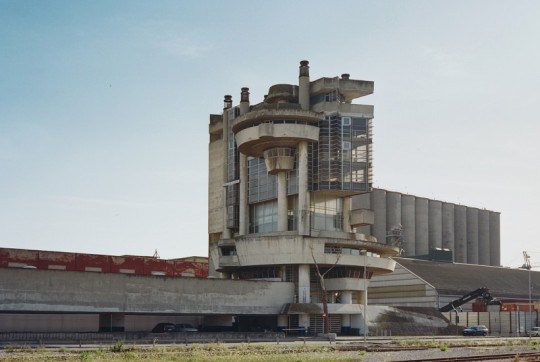
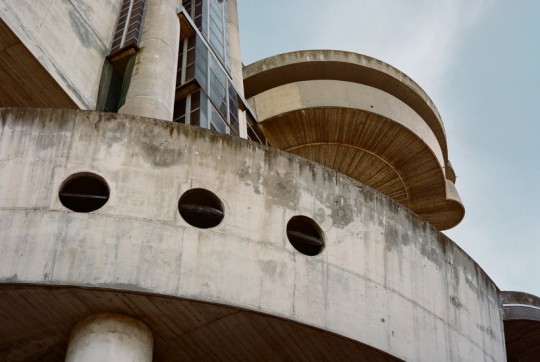
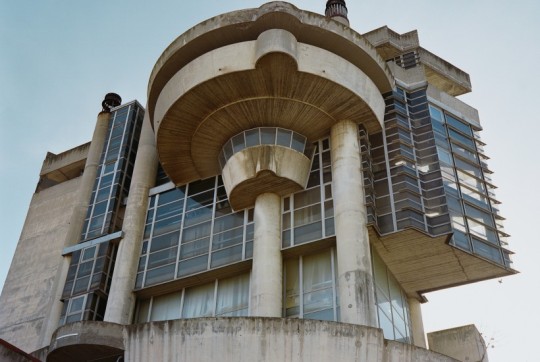
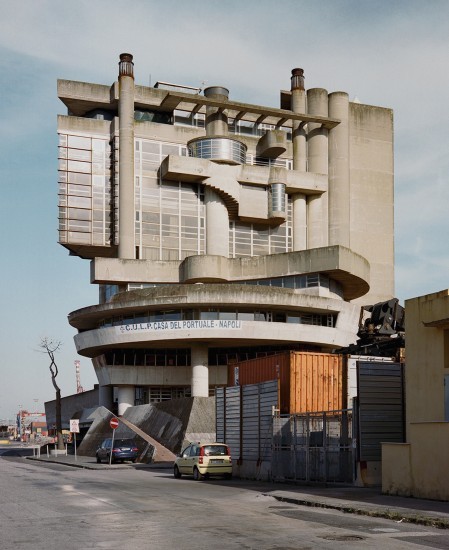
THE ABANDONED BRUTALIST CASA DEL PORTUALE, A BUILDING FOR “SOCIAL SERVICES FOR WORKERS IN THE PORT OF NAPLES” BY ARCHITECT ALDO LORIS ROSSI, NAPLES
An immersion in the most iconic building from the port of Naples. Casa Del Portuale by ALDO LORIS ROSSI is an example of architect’s fascination with modernism, futurism and large scale. Built between 1968 and 1980, it served as a social building for harbor’s workers and was inspired by Stalinist architecture. Now, the industrial masterpiece is lost, empty, and left for dead. Offices swept by wind and large bloodstains on the rooftop plunge us into a worrying scenario of mafia movies. Voir Naples et mourir?
Text and photo: Tom de Peyret & Marine Brutti
34 notes
·
View notes
Note
🔂 for the ask please, Sen!!!
jen! hi!!!!
🔂: Fic I’ve read more than once
the thing about me is that i'm a chronic re-reader. like. i even have a bookmark tag dedicated to fics that i know i will/want to reread!
but. i will give you two that i know i've read a lot!
show me the place where he inserted the blade by the brilliant and wonderfully talented @cheatghost
+
brutalist masterpieces by @greatunironic
both of those fics altered my brain chemistry FR and i did essentially write a series of essays bases on playlists for SMTP so you know i've read that one a bunch. but all those fics in that tag are SOOOOOO!!!!!!
✨fic rec challenge✨
#ask game#steddie fic rec#this game is having me itch to make a full on post for recs#but also get back into reading more!
12 notes
·
View notes
Note
hello I am screeching in here on two wheels after devouring brutalist masterpieces in a fugue state and I have to know if there was any additional planned significance behind the name S.R. Lane. I know Steve in the fic says Lane was his mother’s name, but what about the other part? Is S for Steve? Is R for Robin??? Or am I already losing my grip on reality after reading this
listen i’ve never been more excited for an ask because i was DESPERATELY hoping someone would pick up on this and —
yes yes yes a million times yes, the “r” is 100% for robin, steve had to keep her close anyway he could, she does cry when she finds out (after punching him directly in the kidney)
67 notes
·
View notes
Text
Last Monday of the Week 2023-06-26
I have learned so many new things about the specifics of the GPL against my will.
Listening: Remembered that I was kind of hyped for Rodrigo y Gabriela's new album "In Between Thoughts... A New World" which is just a lot of showing off on the guitar. Very much the soundtrack to a movie that doesn't exist.
Reading: Finally remembered the books I was reading long enough to finish Children of Time. Bizzare ending, not bad, but I can see why this might lead to a less well received second book. Spidertech gets increasingly ridiculous in ways that are just on the balance of predictable and ridiculous that I find very funny. They do computing on ants. Also there is an entire society of intelligent mantis shrimp in the periphery of this book. They need a spin-off.
Started Kaiju Preservation Society by Scalzi. I have not in fact read very much Scalzi but this one did sound funny and I was down for sci-fi comedy.
Watching: Continuing the Fast and Furious Watch, with The Fast And The Furious (2009) which is the second movie called that. This feels like it's resetting the storyline so that they can go wherever they're planning on going with this. I liked it a normal amount! There is a level of restraint on display that does not come to mind when I tell you that within 5 minutes of the movie starting, Vin Diesel has driven a car underneath an exploding fuel tanker truck.
Playing: a lot of Mars First Logistics, the recently-in-early-access mars cargo robot building game.
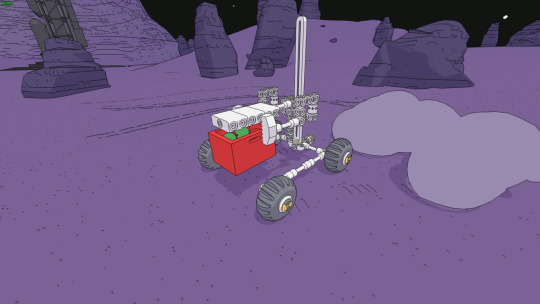
A good balance of constrained and freeform, parts are slowly meted out as you progress through the "story missions" in as much as those exist, which sees you building a rocket, a biosphere, a rover soccer stadium, a resort, etc. out of ever more unwieldy components in ever more inhospitable terrain.
At times navigation can become just straight up ridiculous, forcing you to either charge up and down steep hills with unstable cargo or attempt to gradually work your way the slow way around. A very forgiving vehicle reset and a less forgiving cargo reset goes a long way to making this manageable. You always have the option to strap rockets to your vessel and cast yourself to the wind, which comes in handy pretty often.
Making: Sat down with FreeCAD and sketched out the apartment for future use, now I need to do the furniture. FreeCAD is not the best or the worst CAD package I've used but it's basically the only one that runs on Linux, unless you have several thousand dollars to drop on Siemens NX. A halfhearted attempt to throw the skeleton of the apartment at povray resulted in this brutalist masterpiece.

Tools and Equipment: I got the iFixit Prying and Opening Tool Kit which is a set of plastic wedges, spudgers, and cards intended for opening electronics. I've always just kind of done this with whatever is lying around and I gotta say it's a big improvement. They're decidedly consumable parts, but they're also cheap enough to justify that.
8 notes
·
View notes
Text
Romancing the stone: identity and architecture in Finland (To HEL and back 4)

In Helsinki, it pays to look where you walk. I mean look up, not down - the pavements are spotless here, unlike in Paris.
This Finnish capital, my colleague Risto told me, is an architectural feast for the eyes.
So we've found it to be. But thus far we've only explored the column-heavy, neoclassical centre of the city. Those pre-1850 buildings are scaled-down versions of the stuff you can see on the London Mall, the Place de la Concorde or across Washington.
During our first walk two days ago, however, we got glimpses of a funkier side to Helsinki's cityscape.
A stone’s throw from the Protestant cathedral (built 1830-1852 - below left) is the Russian orthodox one built from from the 1860s (right).
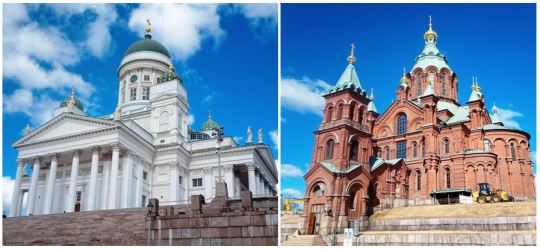
Any orthodox cathedral, you might say, is bound to be more ornate than a Lutheran one.
The inside of Helsinki's Upenski cathedral is gloriously tacky:

But the differences in design reflect more than a theological split.
The second half of the 19th century saw a movement towards glorious tackiness in Western art.
Operetta replaced opera as the most popular form of musical drama. Architecture lightened up in the same way, and Helsinki, a small city, is ideal for observing that shift.
Behind the Russian cathedral is this layer-cake of a building:

Note the fancy carvings at the top and the rough, Nordic stone near the bottom.
The 1890s block of flat was designed by Gustaf Nyström, a master of Finland’s neo-Renaissance movement.
Just down the road is his magnum opus, the 1902 custom house:

The culmination of this movement was National Romanticism, Finland’s equivalent of Art Nouveau.
Before I left, Risto wrote the vernacular phrase for me on a piece of paper: "Kansallisromanttinen arkkitehtuuri."
He articulated it in that heartfelt Uralic staccato that sounds much nicer to my ears than French (although that’s probably because I understand what French people say.)
Now in situ, I tap the phrase on my phone. Google takes us to this:

By the turn of the century, when the Finnish National Theatre (above) was built, Finnish granite is all over buildings.

The Pohjola Insurance (above) building dates from 1899.
Unlike neoclassicism, which reflected the might of the state, the National Romantic style was driven by bourgeois commercialism.
The Wasa Bank building (below) is a prime example of new money reinventing the old world.

It may seem paradoxical that capitalism, in its moment of triumph, should wallow in nostalgia for pre-industrial times.
But revolutions often justify upheaval by harking back to the past. Britain’s Arts and Craft and neo-Gothic fashions were championed by captains of industry.
Thus the new armies of pen-pushers and factory drudges could think of Merrie England as they trundled to work.
The equivalent, it seems, happened on these Baltic shores.
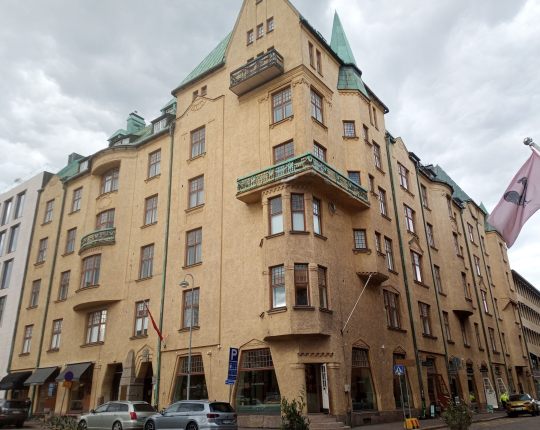
Another key aspect of Finnish National Romanticism is its appeal to the country's mythical heritage.
It's sometimes called "Karelian architecture". Most of ancient Karelia was absorbed into Russia long ago, but that's where many Finns fancied their roots were.
Traditional Karelian designs were carved in wood. Romantic nationalist designers tried to set them in stone.
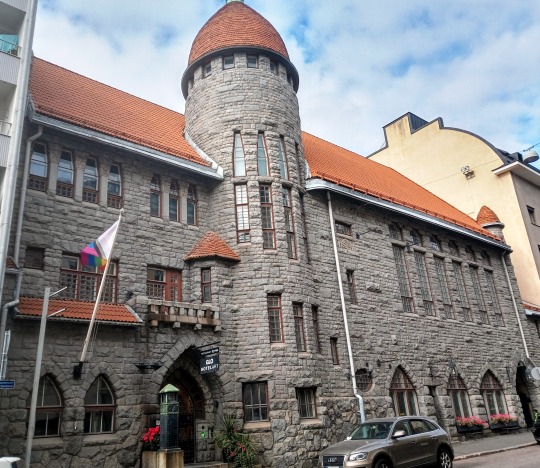
I'm not sure what Karelian motifs look like, but I suspect they can be found on the façades of the Polytechnic Students' Union (1903, above) and the Nylands Nation building (1904, below).
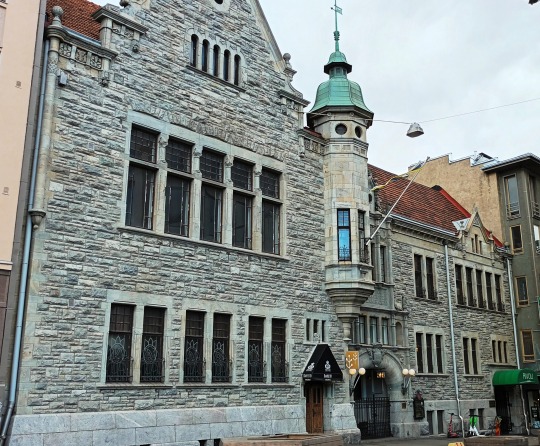
But for some reason, around 1905 Finnish architects move on from National romanticism.
Quirky neo-medievalism fades into something starker. Might and massiveness return.
Large institutions are back at the forefront of architectural innovation.
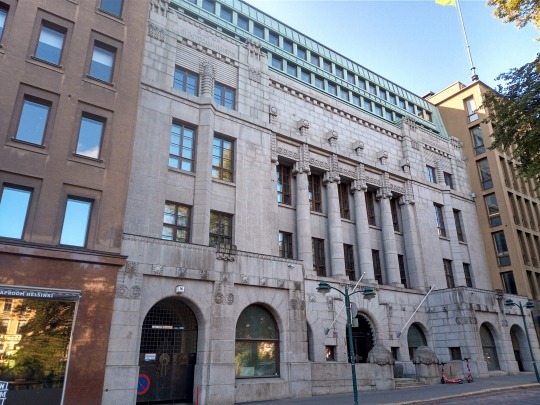
The Transport Ministry building (1909, above) and the Helsinki stock exchange (1912, below) are the work of the great Lars Sonck.
Both structures make you feel small, not nostagic. They foreshadow the forcefulness of Art Deco geometry.
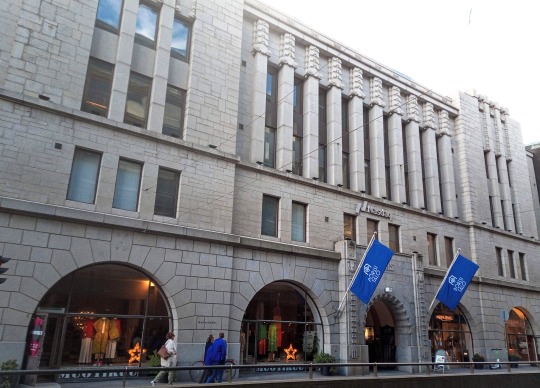
When asked to build a warehouse for the customs service, Sonck came up with this pre-brutalist behemoth – now a smart hotel:
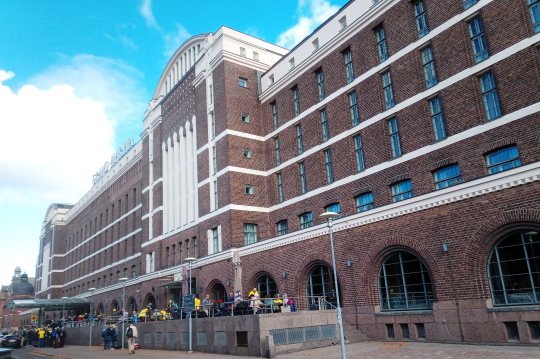
Another of his masterpieces was this church in the Kallio district (1912).
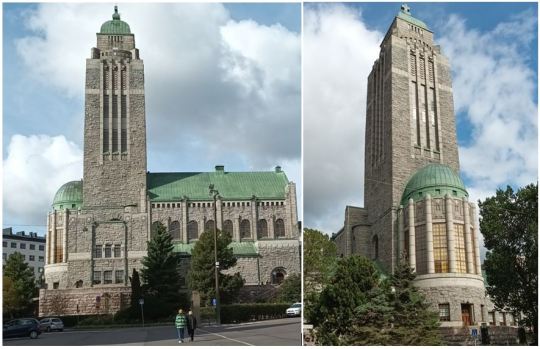
Incidentally, when exploring Helsinki's architectural riches, I recommend taking advantage of its cheap, efficient transit system (the only thing that's cheap here).
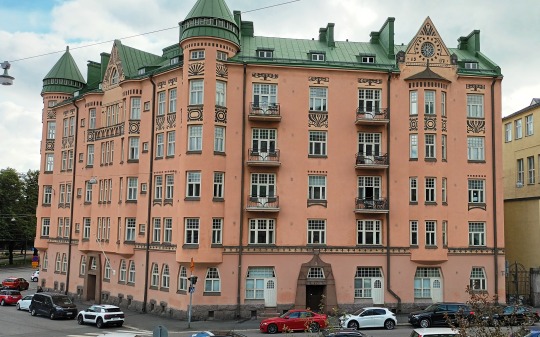
Kallio, a working-class district well on the way to gentrification (above), is infused with utopian spirit of early 20th-century city-planning.
Also a short tram ride from the centre but on the other side of town - both in geographical and sociological terms – is the Eira neighbourhood.
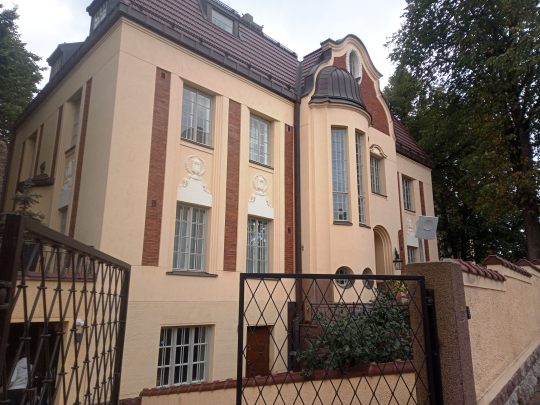
Eira is what the British call would call a garden suburb. Built in the second decade of the 20th century, it includes opulent blocks of flats, large single-family homes and embassies.
There are few right angles: the streets weave and wind around a small central park.
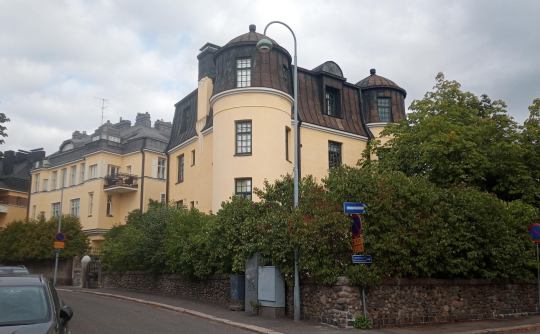
Another remarkable Art Nouveau neighbourhood is the Katajanokka peninsula, just east of the city centre.
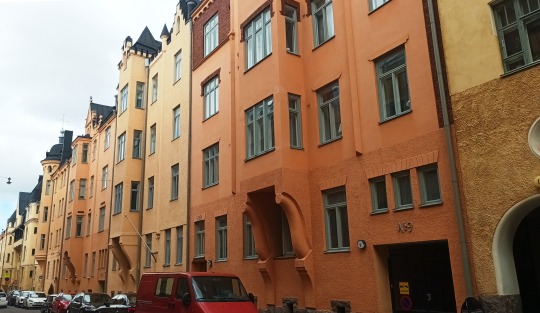
Katajanokka was a slum until these apartment blocks went up in the early 1900s.
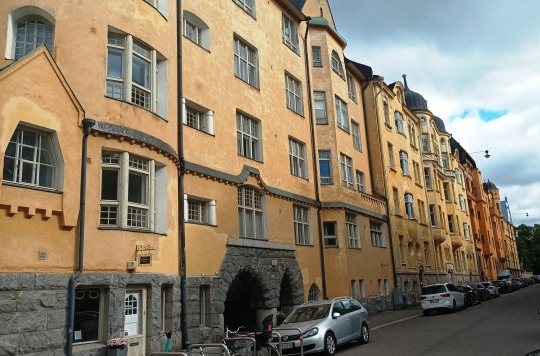
Back in city centre, we find the most striking expression of raw, post-romantic assertiveness: the central railway station.
Its mighty entrance is pictured at the top of this post.
The station opened in 1919, two years after Finland won independence from Russia. A century later, it is flying the Ukrainian flag.
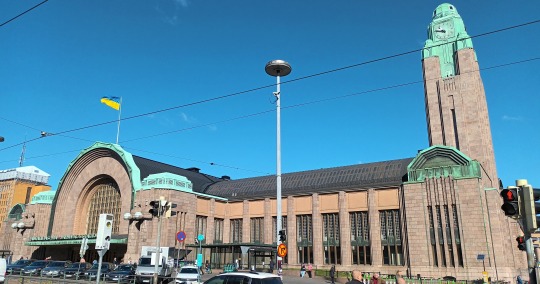
Finnish architecture has continued to break new ground over the past 100 years.
However it's now late afternoon and we don't have time to hunt for Helsinki's modernist wonders, which are scattered towards the outskirts.
We only manage to spot the 2018 Oodi library from afar.

One question has been bothering me all day.
Neo-gothic in Victorian Britain and Haussmannian bombast in France were in vogue for decades. Why did Finnish National Romanticism take hold so spectacularly around 1895, only to go out of fashion 10 years later?
We repair to Helsinki's architecture museum to find out. We have to be quick.
"The museum closes in 45 minutes," the woman at the till says. "You might want to come back tomorrow."
"We're flying back in less that 24 hours," I snap. "I need answers NOW."
She hands us the tickets, unfazed by my impatience.
I run up the stairs. The first room is dedicated to a celebration of Finland's female architects down the ages. The sign reads:

I'm all for feminism, but I've come here for factual information, not inspirational homilies.
The exhibition on "architecta" says nothing about national romantism or any other movement. I’ve just wasted 10 precious minutes.
I try the adjoining room, where another sign explains why, on second thoughts, it's wrong to even talk about women architects:
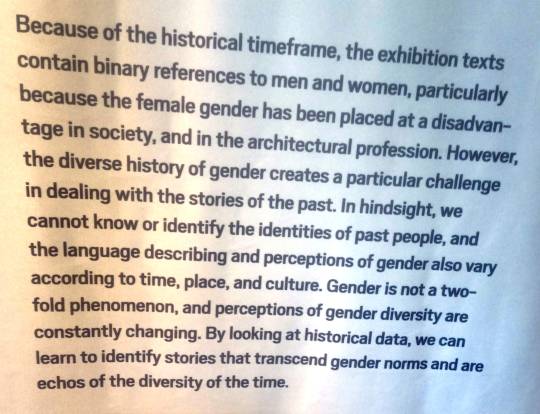
By now I'm ready to throttle the curator – or worse: call them by the wrong pronoun.
But wait! Signs point to an upper floor. I race up another flight of stairs.
Tucked away in a corner of Helsinki's architectural museum I find a display about the architecture of Helsinki.
The information I need is revealed to us in lucid, succinct prose - I suppose the writers had to be succinct given the limited space they were given.
The gist is this: Czars, who had been exercising benign suzerainty over Finland, turned into control freaks at the end of the 19th century, spurring a movement of national awakening.
Artists got with it. Identitarian sentiment infused works like Sibelius’ Karelian Suite (1893). National Romanticism was the architectural expression of this yearning.
And in a flash, I also understand why it lasted only a decade. I can hear Risto's great-grandfather exhort his compatriots, in hearfelt Uralic staccato, circa 1905:
"Guy, GUYS. Stop dreaming of turrets and medieval guilds. We'll never get a homeland by spinning fairytales. This is the age of ruthless empires. Japan did not defeat Russia with samurai folklore, but with guns. Wake up to the 20th century!"
Sonck's brutalism, I now see, was the consequence of Risto Senior's pep talk. And in 1917, Finland kicked out the Russians. A generation later the tiny nation was able to repel the Red Army.
To this day you don't mess with the Finns. Per capita, they have more people in uniform than any Western country. Despite their woke pieties and genuine niceness, there is steel in these people.
We experience it at our modest level that evening, after dining on locally grown leaves and sustainably roasted zucchini at a ravintola. A smiling waitress hits us with a €145 bill.
The credit card reader cheekily asks me if I'm willing to pay even more: I leave a €20 tip without a squeak.
***
Previous “To HEL and back” instalments:
. L’invitation au voyage
. Guidebooks don’t lie
. How Sweden lost Finland
43 notes
·
View notes
Text
This home is a an unusual interpretation of a mid century modern house combined with brutalist architecture.
2 notes
·
View notes
Photo



official art, unity 8k wallpaper, ultra detailed, beautiful and aesthetic, masterpiece, best quality, (zentangle, mandala, tangle, entangle), (fractal art:1.3) , 1girl, extremely detailed, dynamic angle, cowboyshot, the most beautiful form of chaos, elegant, a brutalist designed, vivid colours, romanticism, by james jean, roby dwi antono, ross tran, francis bacon, michal mraz, adrian ghenie, petra cortright, gerhard richter, takato yamamoto, ashley wood, atmospheric, ecstasy of musical notes, streaming musical notes visible, <lora:FashionMagazineStyle_v10:0.6> <lora:Cnbeauty7_v10:0.4>
Negative prompt: ng_deepnegative_v1_75t, (worst quality:2), (low quality:2), (normal quality:2), lowres, bad anatomy, bad hands, normal quality, ((monochrome)), ((grayscale)),
Steps: 40, Sampler: DPM++ SDE Karras, CFG scale: 7, Seed: 1995754745, Size: 512x768, Model hash: ce4d987a0e, Model: duchaitenaiart_V453
7 notes
·
View notes
Photo

Happy Easter - Buona Pasqua! Foto: © Wolfram Mikuteit
“L'uovo gigante” - un eccezionale esempio di architettura brutalista “lanzonese”. Curioso è “l’uovo gigante", che veniva usato come pollaio! Rinvenuto nel parco di Villa Pastrone a Richiardi / Groscavallo, Val Grande di Lanzo.
A truly masterpiece of italian brutalist architecture. This giant egg served as chicken coop (no joke!) in the park of the “Pastrone” mansion in Richiardi / Groscavallo, Lanzo Valleys, Piedmont.
#architecture#architecturephotography#archdaily#archidaily#blackandwhitephotography#b&w aesthetic#monochrome#bnw#tag1#tag2#tag3#mikuteit#wolfram mikuteit#photographers on tumblr#photographers on instagram#original photography on tumblr#cityphotography#city#urban#urban photography#urban details#lanzo#vallidilanzo#piemonte#pidmont#richiardi#groscavallo
7 notes
·
View notes